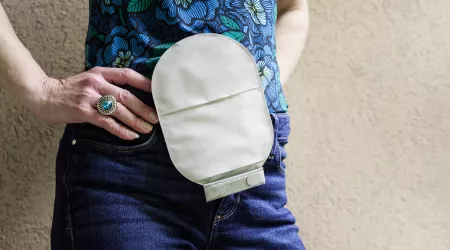3X Match My Gift
Act now through 12/31! Triple your impact to support colorectal cancer patients, survivors, and caregivers.

Exercise with an ostomy can accelerate recovery, enhance balance and flexibility, boost self-confidence, increase energy, and decrease stress.

Navigating an exercise plan after ostomy surgery can be a journey filled with questions and concerns. It's crucial to balance activity with safety to support your healing process.
IMPORTANT: Before beginning any exercise program, consult with your doctor.
Consult your doctor before beginning exercise. Be aware of the weakened muscles around the stoma and minimize your hernia risk.
Walking is a safe and effective exercise for healing and overall health.
Exercise cautiously and allow ample healing time, especially for perineal wounds.
If you experience pain or discomfort, stop exercise immediately. Build up your routine gradually, staying in tune with your body’s responses.
Check with your doctor before starting any sports or fitness activities, especially those involving contact or bending. If approved, you can participate in just about any type of exercise.

Start your on your fitness path with walking. You can do this almost immediately after surgery. Slowly increase the distance and pace over time.

With surgeon approval, biking -- a low-impact activity -- is beneficial post-surgery. If the anus is removed, expect a longer healing period before starting.

Water supports your weight, reducing injury risk and improving flexibility. Ensure your ostomy device is waterproof or use products like Sure Seal. Be sure to check for any leaks damage after swimming and carry backup supplies in your gym bag.

Yoga reduces stress and improves balance, breathing, and muscle strength. Check with your doctor before beginning, as incision sites should be fully healed before starting your plan. When starting, go at your own pace.

Ask your surgeon before starting competitive sports. Empty your pouch before playing and consider wearing tight waistbands or stoma guards for protection. Always check your stoma afterward and report damage or injuries to your doctor right away.

By prioritizing abdominal exercise, you can enhance support of your stoma, reduce the risk of hernias, improve your posture and balance, and accelerate healing and recovery.
These exercises can help recover and restore muscle strength in your abdomen. Talk to your doctor before beginning these routines.
Lie down, knees bent, head on a pillow. Inhale, then exhale, tightening lower abdomen for 3-5 seconds. Relax. Repeat 3-5 times, increasing tightening time as comfortable.
Lie on your back with knees bent. Gently rock pelvis up, flattening your back. Stay in a pain-free range of motion. Your abdomen and glutes should tighten. Begin with five repetitions. Perform two to three times daily.
Lie on your back, knees bent. Tilt pelvis and tighten pelvic muscles. Slowly lift and lower your bottom, one vertebra at a time, like a chain necklace lifts off a table. Start with three to five times daily, aiming for 10-15 reps, gradually lifting higher.
Lie on your back, knees bent, arms to the side. Slowly move knees from side to side, tightening the abdomen. Begin with five reps, two to three times daily, and gradually increase to 20. Stay within a pain-free range of motion.
Feeling accomplished is one of the great benefits of exercise. Keeping a record will show your progress. You'll probably be surprised by the speed of your recovery.
My cancer and ostomy journey began with a rude awakening in January 2023. My father was diagnosed with colorectal cancer at 42, and given that history, I asked my doctor at my yearly physical when I should begin screening.

Every year on the first Saturday of October, people worldwide come together to celebrate World Ostomy Day, also known as Ostomy Awareness Day. This day serves as a reminder of the resilience, strength, and courage millions of individuals display each year living with an ostomy.
In this video, ostomate and certified patient and family support navigator Stephanie Rouse demonstrates how to cut and fit an ostomy wafer, or skin barrier, for a stoma.